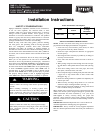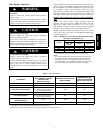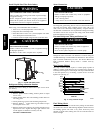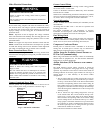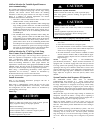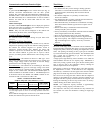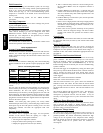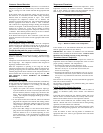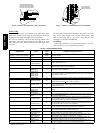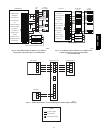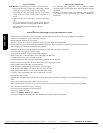
6
Airflow Selection for Variable Speed Furnaces
(non--communicating)
The variable speed furnaces provide blower operation to match the
capacities of the compressor during high and low stage cooling
operation. The furnace control board allows the installing
technician to select the proper airflows for each stage of cooling.
Below is a summary of required adjustments. See furnace
installation instructions for more details:
1. Turn SW1----5 ON for 400 CFM/ton airflow or OFF for 350
CFM/ton airflow. Factory default is OFF.
2. The A/C DIP switch setting determines airflow during high
stage cooling operation. Select the A/C DIP switch setting
corresponding to the available airflow shown in the furnace
Installation Instructions that most closely matches the re-
quired airflow shown in the air conditioning Product Data
for HIGH speed.
3. The CF DIP switch setting determines airflow during low
stage cooling operation. Select the CF DIP switch setting
corresponding to the available airflow shown in the furnace
installation instructions that most closely matches the re-
quired airflow shown in the air conditioning Product Data
for LOW speed. If a higher or lower continuous fan speed is
desired, the continuous fan speed can be changed using the
fan switch on the thermostat. Refer to the furnace Installa-
tion Instructions for details of how to use this feature.
Airflow Selection for FV4C Fan Coils Using
Non--Comm. (Non--Evolution) Thermostats
The FV4C provides high-- and low--stage blower operation to
match the capacities of compressor at high-- and low--stage. To
select recommended airflow, refer to FV4C Installation
Instructions. The FV4C utilizes an Easy Select control board that
allows the installing technician to select proper airflows. For
adjustments to control board, select appropriate HP SIZE and CFM
ADJUST setting. This fan coil has an adjustable blower off delay
factory set at 90 sec for high-- and low--stage blower operation.
When using a communicating (Evolution) control, dipswitch
adjustments are not necessary. Airflows are determined by
Evolution Control setup. The fan coil is the FE4A.
For other combinations of equipment consult Product Data Digest.
Install Accessories
Refer to the individual instructions packaged with kits or
accessories when installing.
When using a communicating control with the fan coil or the
furnace, dip switch adjustments are not necessary. The outdoor
unit configuration and the indoor airflows are determined by
communicating control setup.
Start--Up
CAUTION
!
UNIT OPERATION AND SAFETY HAZARD
Failure to follow this caution may result in minor personal
injury, equipment damage or improper operation.
Observe the following:
1. Do not overcharge system with refrigerant.
2. Do not operate unit in a vacuum or at negative pressure.
3. Do not disable low pressure switch
4. Dome temperatures may be hot.
CAUTION
!
PERSONAL INJURY HAZARD
Failure to follow this caution may result in personal injury.
Wear safety glasses, protective clothing, and gloves when
handling refrigerant.
CAUTION
!
ENVIRONMENTAL HAZARD
Failure to follow this caution may result in environmental
damage.
Federal regulations require that you do not vent
refrigerant to the atmosphere. Recover during system
repair or final unit disposal.
Follow these steps to properly start up the system:
1. After system is evacuated, fully open liquid and vapor ser-
vice valves.
2. Close electrical disconnects to energize system.
3. Set room thermostat or User Interface at desired temperat-
ure. Be sure set point is below indoor ambient temperature
and is set low enough to energize desired stage.
4. Set room thermostat or User Interface to HEAT or COOL
and fan control to AUTO or ON, as desired. Wait for appro-
priate time delay(s). Operate unit for 15 minutes. Check re-
frigerant charge.
NOTE: Systems using only a non--communicating
(non--Evolution) thermostat, Bryant electronic thermostats are
equipped with a 15--minute staging timer. This timer prevents the
two--stage system from operating at high stage until unit has been
operating in low stage for 15 minutes, unless there is at least a ±5°F
(±2.8°C) difference between room temperature and thermostat set
point. To force high stage (after a minimum of 2 minutes in low
stage), adjust the set point at least ±5°F(±2.8°C) below room
ambient.
System Functions And Sequence Of Operation
The 286B/289B models utilize either an Evolution
Communicating User Interface or a 2-stage cooling indoor
thermostat. With a call for first stage cooling, the outdoor fan and
low-stage compressor are energized. If low-stage cannot satisfy
cooling demand, high-stage is energized by the second stage of
indoor thermostat. After second stage is satisfied, the unit returns to
low-stage operation until first stage is satisfied or until second stage
is required again.
When both first stage and second stage cooling are satisfied, the
compressor will shut off. When a 2-stage unit is operating at
low-stage, system vapor (suction) pressure will be higher than a
standard single-stage system or high-stage operation.
When the outdoor ambient is more the 100_F (37.8_C), the
outdoor fan will continue to run for one minute after compressor
shuts off. This reduces pressure differential for easier starting in
the next cycle.
With non--communicating (non--Evolution) systems, with first
stage of cooling, Y1 and O are powered on; and with second stage
of cooling, Y1, Y2, and O are on. For these systems, with first
stage of heating Y1 is on and for second stage of heating, Y1 and
Y2 are on. When the reversing valve is energized, O is powered
on.
286B / 289B



